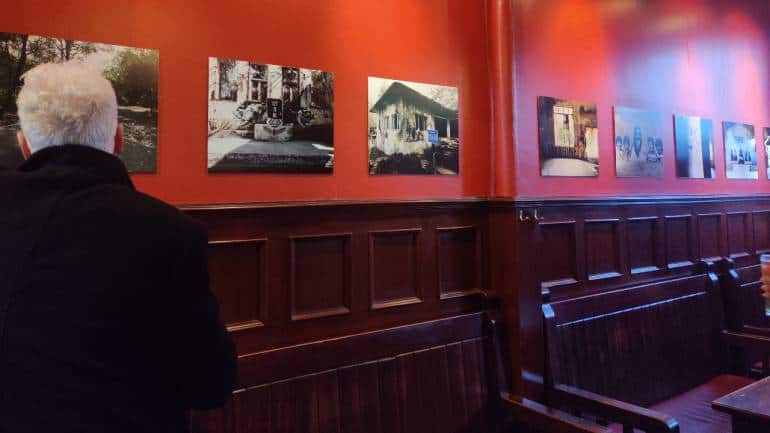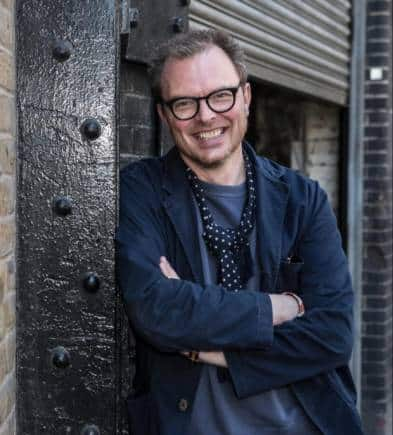



Sometimes, decay, not restoration, may be the best way for a historic moment to present itself. Noted British photographer Michael Donald thought so when he saw the Beatles Bungalow for the first time in Rishikesh.
Fragile, decaying, lost in time, almost like a secret, he remembers.
The bungalow is where members of the iconic British music band stayed in 1968. Alive as a myth in his mind, Donald expected the bungalow to exist bang at the centre of Rishikesh’s tourist enclaves. He didn’t expect what he saw instead: a relic in concrete slowly giving way to the forest.
This decadence, he avers, and the majestic grandeur of it is what drove him to the photography project that is now on display at Belfast’s John Hewitt Bar as part of the Cathedral Quarter Arts Festival, the annual festival of music, comedy, theatre, art, and literature in Northern Ireland.
"The bungalow is decaying but it’s far from derelict. It’s not a sad picture. There is dignity in how it slowly falls apart," Donald says. "The photos of the bungalow serve an essential purpose: to preserve a moment in time that is so important to the band’s musical journey before it’s lost forever," Donald explains.
 The photos are on display till May 20, 2022, as part of Cathedral Quarter Arts Festival.
The photos are on display till May 20, 2022, as part of Cathedral Quarter Arts Festival.The exhibition comes close on the heels of the new solo tour by Paul McCartney, famous as the co-lead vocalist, co-songwriter and bassist of The Beatles, that opened on April 28 in the United States. His first since 2019, the McCartney tour is revisiting some of the most popular Beatles songs.
Donald’s exhibition revisits the band’s legacy visually by capturing the majesty of the bungalow in its bareness, a rare quality for a place left to the vagaries of time, much like the magic of The Beatles that lives on long after their prime. The crumbling paint on the walls, the life-size graffiti, the desolate veranda and corridors that were alive with music once, the bathroom with a large ceramic bathtub, the road leading to the bungalow that "merges into the river", in Donald’s words, are all now part of the exhibition, far from the forest that engulfs them.
Also known as the Maharishi bungalow after spiritual guru Maharishi Mahesh Yogi who hosted The Beatles during their stay in Rishikesh, The Beatles bungalow was shut down for decades until the local government decided to open it for tourists in 2015. Built in 1961 and part of the Rajaji Tiger Reserve, the site is managed by the Uttarakhand Forest Department. Today, there are a few signboards to guide visitors around the place and a security guard oblivious to its historical importance, Donald recalls. "When they opened the bungalow, they just removed the lock from the rooms and that’s it. It seems so real, yet surreal, much more substantial than I had imagined," he says.
Like many others, Donald too might have missed the bungalow, if not for a yoga retreat to India planned by his daughter: a trip on which she dragged Donald along, and led him to discover the famous bungalow that now embodies The Beatles and India connection. "My daughter Sorcha was bored of the city life living in London and Madrid. She was looking for a yoga course and found one in Rishikesh," he recalls. At the time, Donald was not aware of Rishikesh’s reputation as the city of spiritual retreats and yoga. All he thought about was his 18-year-old daughter going all the way to the north Indian town via the Indian capital New Delhi to learn yoga and felt anxious as a parent. "The plan was that I would travel with her and be around for a couple of weeks until she settles in," he says.
It was 2020 and the owner of the hotel he was staying in told him about the bungalow first. He was curious, had two weeks to spend in a town he knew little about, and had grown up loving The Beatles. The bungalow was an invitation to explore a part of the musical band’s journey, and also a vocation to pass the time. It clearly turned into something more than that.
"The bungalow surprised me. It has the magic of the band, it still carries their lingering presence, you feel the songs that were written here, and there is nothing between you and the story," Donald says.
His first visit was on a motorbike, taking stock of the place. He returned a few days later, alone, and was soon immersed in what he saw. Over the next two days, Donald shot the bungalow, each room leading him to imagine The Beatles at work - living, dining, bathing, singing, composing the songs. After all, the band’s stay at the bungalow is widely reported to be their most productive. This is where, more than 50 years ago, the band discovered meditation and wrote 48 songs which were included in the chartbusting albums ‘White Album’, ‘Abbey Road’ and ‘Let it be’. The ‘Mother Nature’s Son’ song from ‘The White Album’ portrays the magical environs of Rishikesh.
Yet, for all this history, Donald didn’t have to seek any special permissions to shoot, as the bungalow had very few visitors. "I soon realised no off-hour permissions were needed," he says. Where Donald comes from, heritage preservation is a serious, time-consuming affair, backed by generous funds from the government and individuals alike. From popular British tourist sites such Stonehenge to numerous castles across the country, heritage conservation is professionally managed by English Heritage, a registered charity dedicated to conservation.
For Donald, the contrast of the bungalow’s state of disrepair was thought-provoking. "As a photographer, it was fascinating. I imagined what it would be like if anyone took conservation of the bungalow seriously. Maybe, in a few years, it would be taken over by a hospitality group and turned into a museum or a spa. Maybe, it would be restored to an extent where it’s transformed into something else, I don’t know! So for me, the fact that they opened the bungalow to the public in this bare state was perfect. This kept the spirit of it intact," he says.
In the same breath, Donald refers to the Titanic Museum in Belfast, Northern Ireland, restored as a reminder of the city’s history as the very place where RMS Titanic was designed, built and launched and of her maiden voyage and collapse in the North Atlantic Ocean four days into later en route to New York City in 1912. "Before the museum and the movie, Belfast was shamed for the collapse of the Titanic. In retrospect, with projects to commemorate it, Titanic has claimed its place in history," he says.
 Photographer Michael Donald
Photographer Michael DonaldBorn and raised in Belfast, Northern Ireland, Donald grew up with a love for music, particularly The Beatles. Discovering the world through music and photography, Donald found himself at the Rolling Stones show at Slane Castle in Dublin when he was 14. His "best shot" from the day is a psychedelic capture of a moment from the show where the legendary Mick Jagger appears as a red and white dot in the middle. From then on, Donald went on to do much more, including shoots for British mainstream newspapers, direct award-winning films, a book project for FIFA, and several exhibitions from London to Paris and Los Angeles, most notable among them being the contemporary portraits of the Rolling Stones, and Leonard Cohen. He has since won a John Kobal Photographic Portrait Award, and Prix de la Photographie award in Paris.
While Donald’s photography career has followed the music everywhere, the bungalow became the unlikely muse. "The exhibition evolved with other people’s interest in the project since I shot the photos. I was primarily there as a parent and then ventured out, taking pictures because that’s in my DNA, that’s what I do. From the moment I learnt about it, it became an absolute must-to-visit the place. Even then, I took the pictures as a memory project for preserving moments from our India trip, as a gift for my daughter," he says.
Donald remembers watching New Zealand–based director Peter Jackson’s The Beatles: Get Back, a three-part, eight-hour Disney+ docuseries culled from the dozens of hours of footage and audio recorded as the band worked on the songs released in the 1970 film and album 'Let It Be', full of fresh insights into the inner workings of one of the greatest rock-and-roll bands of all time. That inspired him to do more with the photographs.
The Beatles as a band capture a vast range of human experiences; their songs revolutionized pop music and influenced future generations of musicians. Not just this, The Beatles brand today continues to prevail through musicals, films, television commercials, and archival rereleases. All of this is well-documented, supporting a flourishing cottage industry around the enduring mystique of the band. Donald’s photos look at the less obvious, least celebrated, now in ruins. For Donald, this is what makes it compelling. "These are not just beautiful records of a moment in time, or a mere piece of history. These are emotionally charged photographs of a place, emotive visuals of a place that may be lost soon. But then, one listens to their music and then looks at the photos, that’s the experience you want to live on forever," he says.
The photographs are on display at the John Hewitt Bar in Belfast from May 1 - 20, 2022, as part of Cathedral Quarter Arts Festival. Archival 20x16 inch prints are available for purchase here. Editions of 50, each signed by Michael Donald.Discover the latest Business News, Sensex, and Nifty updates. Obtain Personal Finance insights, tax queries, and expert opinions on Moneycontrol or download the Moneycontrol App to stay updated!
Find the best of Al News in one place, specially curated for you every weekend.
Stay on top of the latest tech trends and biggest startup news.